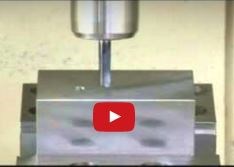Video: Flat-Bottom Drill Versus Conventional
See how a flat-bottom drill tends to shear material as it exists the back side of a workpiece, leaving behind a minimal burr.
Share




Flat-bottom drills are nifty tools. Those that have true 180-degree flat cutting edges can create holes on inclined or curved surfaces without a preliminary center drilling operation to create a start hole. And unlike conventional drills, flat-bottom drills tend to shear material as it exists the back side of a workpiece instead of pushing through, leaving behind a minimal burr.
The video above demonstrates this. Produced by Nachi, it shows a slow-motion comparison of a conventional drill and the company’s Aqua Drill Ex Flat completing a through-hole. You can see the tip of the conventional drill pushing through the material, whereas the flat-bottom drill performs more of a shearing operation. The video also shows the flat-bottom drill creating holes in inclined and contoured surfaces without requiring a starter hole.

Related Content
-
Ceratizit Offers Custom Boring Tool for Heavy Goods Vehicles
The boring tool roughs, chamfers and reams/fine finishes holes in a single operation.
-
Form Tapping Improves Tool Life, Costs
Moving from cut tapping to form tapping for a notable application cut tooling costs at Siemens Energy and increased tool life a hundredfold.
-
Ceratizit Product Update Enhances Cutting Tool Solutions
The company has updated its MaxiMill 273-08 face mill, WPC – Change Drill, as well as the HyPower Rough and HyPower Access 4.5-degree hydraulic chucks.




















